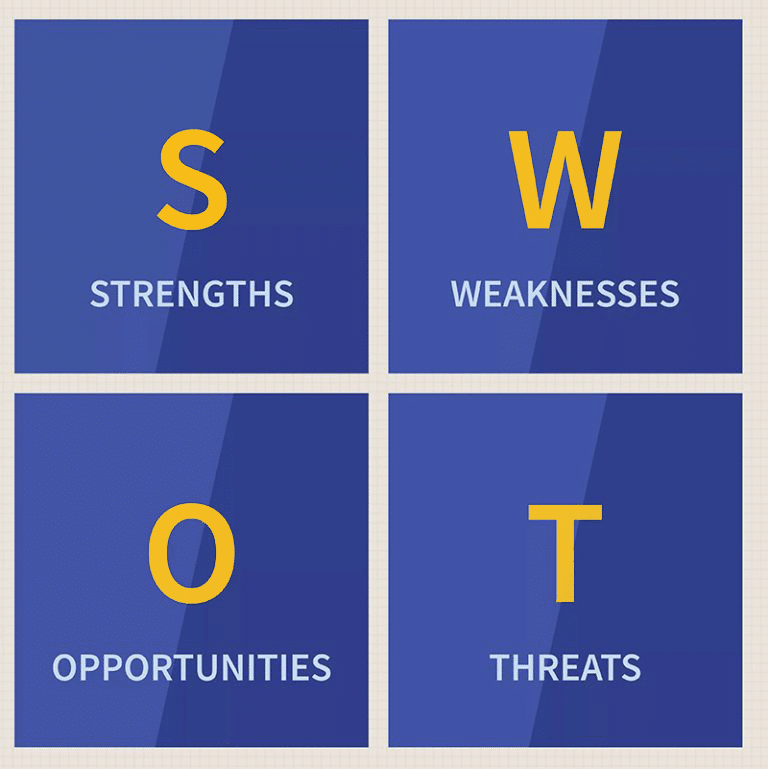What is swot analysis and why is it important
What is swot analysis and why is it important; The question that we are going to examine .and answer in this article
SWOT analysis is one of the simple yet powerful tools for formulating strategies for different companies.
A SWOT analysis helps you formulate a strong strategy for your organization by considering all the strengths and weaknesses of your business, as well as the opportunities and threats you face in the market.
What is a swot analysis
With open eyes, if we want to take a step, we must first look at ourselves and the situation we are in (weaknesses and strengths) and then examine the opportunities and threats facing us, and this means SWOT analysis.
- Strengths
- weak points
- Opportunities
- threats
SWOT analysis is designed to facilitate a realistic, fact-based, and data-driven examination of an organization’s strengths and weaknesses.
The organization should carefully conduct the analysis and focus on the facts and facts, avoiding preconceived beliefs or ambiguous areas. Companies should use this analysis as a guide and not necessarily as a recommendation.
This method was proposed for the first time by these people: Kenneth Andrews/Roland Christensen/William D. Book
SWOT analysis is very necessary before entering any market and generally any time we want to increase the feedback of our digital marketing and advertising activities.
In this method, all the internal and external elements of the company are examined, and by discovering the weaknesses, strengths, opportunities, and threats, your company will be more prepared for future market events.
Understanding SWOT analysis
SWOT analysis is a technique for evaluating the performance, competition, risk, and potential of a business as well as a part of it such as a product line or other entities.
A SWOT analysis using internal and external data can tell a company what it needs to improve internally and also help develop strategic plans.
This technique can also guide businesses toward strategies that are more likely to be successful. A SWOT analysis tells independent analysts, stakeholders, or competitors whether a company, product line, or industry is strong or weak, and why it is strong or weak.

Analysts present a SWOT analysis in the form of a quadrilateral. This visual layout provides an overview of the company’s position. While not all points may be of equal importance, they should all reveal key insights about the balance of opportunities and threats, advantages and disadvantages, and more.
SWOT analysis was first used for business analysis. It is now often used by governments, nonprofits, and individuals, including investors and entrepreneurs.
- Strengths
Strengths describe what an organization has and what separates it from its competitors: for example, a strength can be a strong brand, customer loyalty, unique technology, etc.
For example, a hedge fund may have developed a proprietary business strategy that reverses market losses. The organization must decide how to use these results to attract new investors.
- Weaknesses
Weaknesses do not allow the performance of the organization to reach the optimal level. They are the points that the business needs to improve to gain an edge over the competition. Common weaknesses include a weak brand, higher than average employee attrition rate, high level of debt, inadequate supply chain, or lack of capital.
- Opportunities
Opportunities refer to favorable external factors that can provide a competitive advantage to the organization.
For example, if a country lowers tariffs, a car manufacturer can export its cars to a new market, increasing sales and market share.
- Threats
Threats include factors that have the possibility of harming the organization. For example, drought is a threat to a wheat production company because it may cause the loss or weakening of crop yield. Other common threats include things like the rising cost of materials, increasing number of competitors, tight supply of labor, etc.
Advantages of using SWOT analysis
SWOT analysis is a great way to guide strategic business meetings. It is possible that everyone in the meeting can discuss the main strengths and weaknesses of the company and then define the opportunities and threats and finally address the main ideas.
Often, a SWOT analysis will reveal factors that you were unaware of and that you would not have noticed without doing this analysis.
Companies can use SWOT for meetings related to overall business strategy or for a specific department such as marketing, production, or sales. Over time, you will see how the overall strategy developed from the SWOT analysis will be applied to sub-departments as well.
The main applications of SWOT analysis are in these 3 cases:
- At the beginning of designing marketing campaigns
- Adopting different work policies in your business
- Discovering suitable situations to implement changes in the company
Andrew Charge, the CEO of Money Crashers, says:
The mistake of most managers is that they ignore the process of such an analysis and are satisfied with a thumb and mental calculation. But every business needs the most accurate type of SWOT analysis.
Shawn Walsh, director, and owner of Paradigm Computer Consulting believes that SWOT analysis should be done as a team:
It is better in addition to the company president and marketing managers, other company employees are also involved in the SWOT analysis process and they also have a share in identifying the company’s opportunities, threats, strengths, and weaknesses. Do a SWOT analysis of your business as a team.
Once you know all the risks to your business, you can decide whether to: Fix the internal weaknesses of your business.
Or, for the time being, I should block that part of the market that has threats to me and leave it for another time when I am ready to deal with it.
Internal factors
The first two letters (S and W) which represent strengths and weaknesses are both internal factors related to your business. Internal factors such as the following you should see what are your strengths and weaknesses in each of them:
- Financial issues: such as budget, source of income, debt, and…
- Marketing communications: experienced visitors, strong product distribution system, reputation, and…
- Physical resources: such as the location of your company (the same address as the office!), your company’s facilities and equipment, etc.
- Human resources: your employees, your brand fans (and of course your brand haters!) and…
- Legal issues: patent, intellectual property rights, brand registration, and other legal issues
You may have strengths or weaknesses outside of the above categories. This category is just a kind of guide to better find your strengths and weaknesses.
External factors
These factors will either directly or indirectly affect your business. Now it may present opportunities, or, unfortunately, threats to your business:
- Market situation: such as new products, new technology, or, for example, changing customer needs
- Economic Status: The economic status of your city, country, or the world
- Budgeting: for example, different loans or tax discounts and…
- Communications: opportunities and threats that arise in your communications (eg with suppliers, shareholders, business partners, etc.).
- Political situation: new parliament laws, animal rights protection laws, economic austerity plans, domestic production support plans, and…
- Calendar: cold winter, Nowruz Eid, summer heat, exam days, and…
If you want to advance your work quickly, read the article “Principles creative personal branding“.
SWOT matrix
Once you have identified the strengths and weaknesses, opportunities and threats, you can use the SWOT matrix to design a suitable strategy for your activities. In this way, you can strategize in 4 different ways:
SO Strategies: Use your strengths to exploit your opportunities.
WO strategies: taking advantage of opportunities that can be used to overcome your weaknesses.
WT strategies: It is a type of defensive strategy; When due to our weaknesses, we may suffer a lot from threats.
ST Strategies: In this strategy, you use your strengths to neutralize your threats.
Conclusion
- SWOT analysis is a strategic planning method that provides you with an evaluation tool.
- Identifying key strengths, weaknesses, opportunities, and threats leads to fact-based analysis, gaining fresh perspectives and new ideas.
- SWOT analysis works when diverse groups in the organization are freely able to provide factual data.
Frequently Asked Questions:
What is the definition of SWOT in simple language?
A SWOT matrix is a systematic tool to discover strengths, weaknesses, opportunities, and threats.
Why do we need SWOT?
SWOT is a necessary process for business that evaluates the internal and external environment of the business.
Where can I get a SWOT sample?
You will see how to create it by referring to this article.
In this article, we talked about “What is swot analysis and why is it important” and examined all its aspects. If you also have a tip that can complete this article, share it with us.

